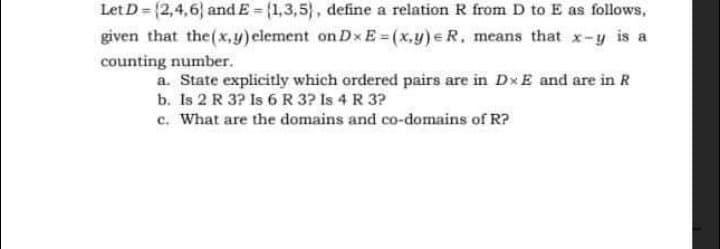Let D = {2,4,6} and E = (1,3,5}, define a relation R from D to E as follows, given that the(x,y)clement on Dx E = (x,y) e R, means that x-y is a counting number. a. State explicitly which ordered pairs are in DxE and are in R b. Is 2 R 3? Is 6R 3? Is 4 R 3? c. What are the domains and co-domains of R?
Let D = {2,4,6} and E = (1,3,5}, define a relation R from D to E as follows, given that the(x,y)clement on Dx E = (x,y) e R, means that x-y is a counting number. a. State explicitly which ordered pairs are in DxE and are in R b. Is 2 R 3? Is 6R 3? Is 4 R 3? c. What are the domains and co-domains of R?
Elements Of Modern Algebra
8th Edition
ISBN:9781285463230
Author:Gilbert, Linda, Jimmie
Publisher:Gilbert, Linda, Jimmie
Chapter1: Fundamentals
Section1.2: Mappings
Problem 27E: 27. Let , where and are nonempty. Prove that has the property that for every subset of if and...
Related questions
Question
100%

Transcribed Image Text:Let D = {2,4,6} and E = (1,3,5), define a relation R from D to E as follows,
given that the(x,y) clement on Dx E = (x,y) e R, means that x-y is a
counting number.
a. State explicitly which ordered pairs are in Dx E and are in R
b. Is 2 R 3? Is 6 R 3? Is 4 R 3?
c. What are the domains and co-domains of R?
Expert Solution
This question has been solved!
Explore an expertly crafted, step-by-step solution for a thorough understanding of key concepts.
Step by step
Solved in 4 steps with 4 images

Knowledge Booster
Learn more about
Need a deep-dive on the concept behind this application? Look no further. Learn more about this topic, algebra and related others by exploring similar questions and additional content below.Recommended textbooks for you

Elements Of Modern Algebra
Algebra
ISBN:
9781285463230
Author:
Gilbert, Linda, Jimmie
Publisher:
Cengage Learning,

Elements Of Modern Algebra
Algebra
ISBN:
9781285463230
Author:
Gilbert, Linda, Jimmie
Publisher:
Cengage Learning,